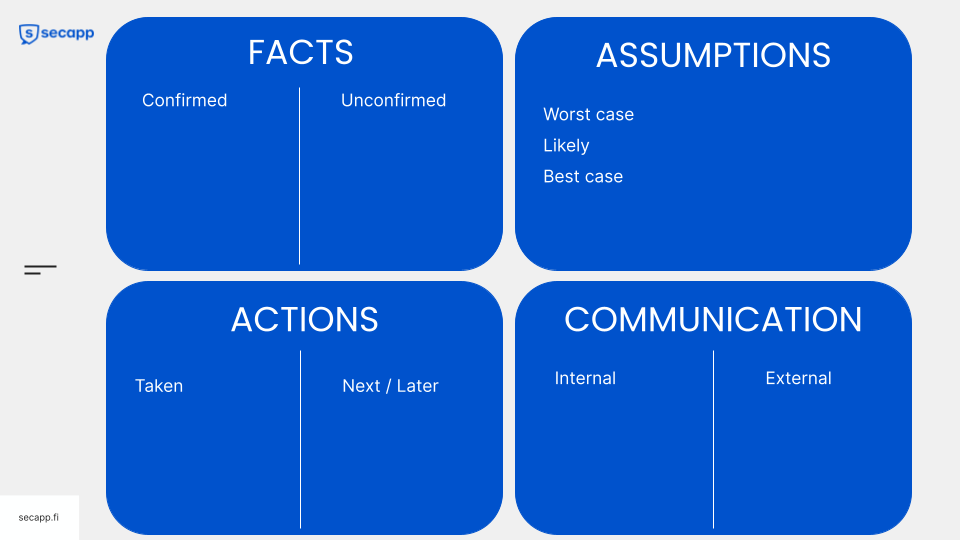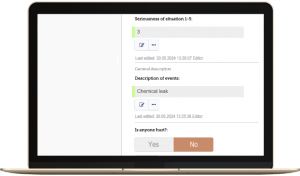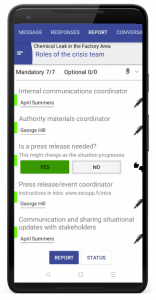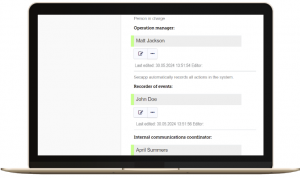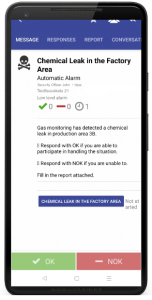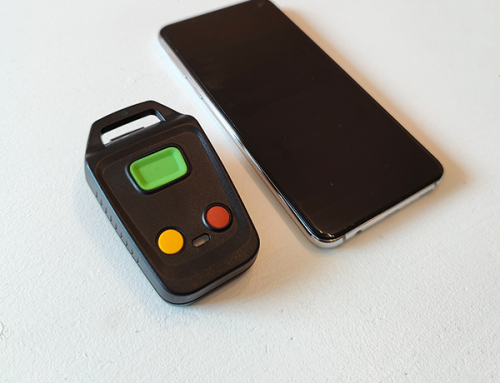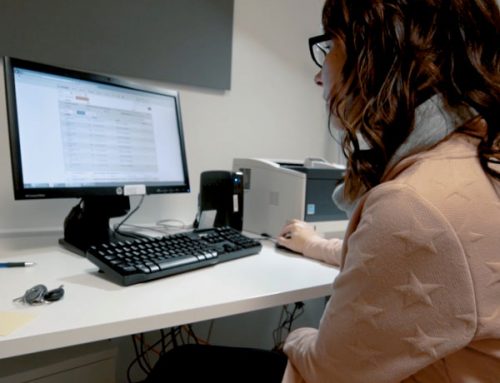
Secapp’s virtual Situation Center enables the real-time coordination of actions and provides collaboration tools, with which individuals and groups can perform tasks simultaneously and share information during crises and exceptional situations. With Secapp’s Situation Center, the virtual crisis room is always with you, regardless of time and place. The Situation Center works on mobile devices and browsers, and you can also use it on the display wall of a situational management or control room.
With Checklists, you can digitize, for example, action cards for crisis situations into Secapp. Each alert can include its own Checklist. This helps the recipients of the alert to immediately understand what actions each person needs to take and report. Many people can fill out the Checklist at the same time, and the participants of the alerting situation as well as those managing the situation can follow the filling of the list in real time.
This is how it works
Take your crisis action cards into Secapp. Transfer your organization’s action cards into digital Checklists. In just minutes, fill in the content of the cards into different data fields such as titles, tables of contents, text fields, and yes/no questions. Add instructions to the Checklists about what actions each person must take in different emergencies, crises and exceptional situations. The Checklists are immediately ready when needed, so no valuable time is spent searching for paper documents or separate files containing instructions. This significantly enhances your organization’s preparedness and readiness to react to different situations.
For example, the topics included in the following action cards can be easily transferred into digital format in Secapp:
Actions, facts, assumptions and communications can be recorded in Secapp, for example, by using the following types of yes/no questions and text fields. In addition to the answers, Secapp automatically records information about who has edited the answers and when.
Define the recipients, roles and responsibilities in advance. In Checklists and ready-made message templates, you can define in advance who is responsible for which task in the event of an emergency – for example, which task belongs to the safety officer or someone who has gone through first aid training. This way, the right people can take action immediately, and everyone also understands the overall picture of what others are doing.
The roles of different people in a crisis situation can be marked in Secapp, for example, in the following way:
Alert. When something happens – for example, an emergency or anomaly is detected – by using a ready-made message template, you can send pre-defined recipients an alert including the actions that need to be taken in the form of a Checklist. You can also link the message template to a Secapp OneClick button, so the entire alerting process starts with just one click of a button.
In the mobile view, the alert looks like this:
Follow in real time. All recipients can follow in real time what actions have already been completed and what will be done next.
Review actions afterwards. All actions are recorded in the system, so you can review the course of actions also after the situation. If you want, you can also get reports from Secapp from all situations within the desired time period. They can be automatically converted into, for example, PDF files that are easy to share to others. Recording the actions is useful if, for example, later there is a need to prove what was done during the situation and whether it was handled appropriately. Additionally, it enables the development of internal processes – what was successful and what was not, what should be improved and what works well.
Share information. A Chat discussion and Meet video call can be attached to each Secapp alert, so that the alert participants can share situational updates in the form of text, photos, videos, voice messages, files or video meetings.

Secapp’s virtual Situation Center enables the real-time coordination of actions and provides collaboration tools, with which individuals and groups can perform tasks simultaneously and share information during crises and exceptional situations. With Secapp’s Situation Center, the virtual crisis room is always with you, regardless of time and place. The Situation Center works on mobile devices and browsers, and you can also use it on the display wall of a situational management or control room.
With Checklists, you can digitize, for example, action cards for crisis situations into Secapp. Each alert can include its own Checklist. This helps the recipients of the alert to immediately understand what actions each person needs to take and report. Many people can fill out the Checklist at the same time, and the participants of the alerting situation as well as those managing the situation can follow the filling of the list in real time.
This is how it works
Take your crisis action cards into Secapp. Transfer your organization’s action cards into digital Checklists. In just minutes, fill in the content of the cards into different data fields such as titles, tables of contents, text fields, and yes/no questions. Add instructions to the Checklists about what actions each person must take in different emergencies, crises and exceptional situations. The Checklists are immediately ready when needed, so no valuable time is spent searching for paper documents or separate files containing instructions. This significantly enhances your organization’s preparedness and readiness to react to different situations.
For example, the topics included in the following action cards can be easily transferred into digital format in Secapp:
Actions, facts, assumptions and communications can be recorded in Secapp, for example, by using the following types of yes/no questions and text fields. In addition to the answers, Secapp automatically records information about who has edited the answers and when.
Define the recipients, roles and responsibilities in advance. In Checklists and ready-made message templates, you can define in advance who is responsible for which task in the event of an emergency – for example, which task belongs to the safety officer or someone who has gone through first aid training. This way, the right people can take action immediately, and everyone also understands the overall picture of what others are doing.
The roles of different people in a crisis situation can be marked in Secapp, for example, in the following way:
Alert. When something happens – for example, an emergency or anomaly is detected – by using a ready-made message template, you can send pre-defined recipients an alert including the actions that need to be taken in the form of a Checklist. You can also link the message template to a Secapp OneClick button, so the entire alerting process starts with just one click of a button.
In the mobile view, the alert looks like this:
Follow in real time. All recipients can follow in real time what actions have already been completed and what will be done next.
Review actions afterwards. All actions are recorded in the system, so you can review the course of actions also after the situation. If you want, you can also get reports from Secapp from all situations within the desired time period. They can be automatically converted into, for example, PDF files that are easy to share to others. Recording the actions is useful if, for example, later there is a need to prove what was done during the situation and whether it was handled appropriately. Additionally, it enables the development of internal processes – what was successful and what was not, what should be improved and what works well.
Share information. A Chat discussion and Meet video call can be attached to each Secapp alert, so that the alert participants can share situational updates in the form of text, photos, videos, voice messages, files or video meetings.

